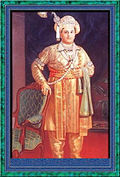- Maharaja of Mysore
-
Maharaja of Mysore Former Monarchy 
Flag of Mysore 
Jayachamaraja Wodeyar Bahadur, the last Maharaja First monarch Yaduraya Last monarch Jayachamaraja Wodeyar Bahadur Style His Highness Official residence Mysore Palace Monarchy started 1399 Monarchy ended 26 January 1950 Current pretender Srikanta Datta Narsimharaja Wodeyar Mysore Kings (1399-1950)
Under Vijayanagara Empire (1399-1565)
Yaduraya (1399–1423) Chamaraja Wodeyar I (1423–1459) Timmaraja Wodeyar I (1459–1478) Chamaraja Wodeyar II (1478–1513) Chamaraja Wodeyar III (1513–1553) Independent Wodeyar Kings (1565-1761)
Timmaraja II (1553–1572) Chamaraja Wodeyar IV (1572–1576) Bettada Wodeyar (1576–1578) Raja Wodeyar I (1578–1617) Chamaraja Wodeyar V (1617–1637) Raja Wodeyar II (1637–1638) Narasaraja Wodeyar I (1638–1659) Dodda Devaraja Wodeyar (1659–1673) Chikka Devaraja Wodeyar (1673–1704) Narasaraja Wodeyar II (1704–1714) Krishnaraja Wodeyar I (1714–1732) Chamaraja Wodeyar VI (1732–1734) Under Haider Ali and Tipu Sultan (1761-1799)
Krishnaraja Wodeyar II (1734–1766) Nanjaraja Wodeyar (1766–1772) Chamaraja Wodeyar VII (1772–1776) Chamaraja Wodeyar VIII (1776–1796) Under British Rule (1799-1947)
Krishnaraja Wodeyar III (1799–1868) Chamaraja Wodeyar IX (1881–1894) Krishnaraja Wodeyar IV (1894–1940) Jayachamaraja Wodeyar (1940–1950) C Rajagopalachari (Governor-General - Republic of India) Maharaja of Mysore was the principal title of the ruler of the Kingdom of Mysore in India.
The Wodeyar dynasty founded a feudatory principality in 1399, which grew into the Kingdom of Mysore. The Wodeyars ruled that kingdom almost uninterruptedly between 1399 and 1947; they ruled initially as vassals of the Vijayanagara Empire (1399-1565), then as independent rulers (1565-1761), then as puppet rulers under Hyder Ali and Tipu Sultan (1761-1796) and finally as allies of the British crown (1799-1947). The Maharajas of Mysore during these 650 years were:
Contents
Maharajas of Mysore
Wodeyar Dynasty (First rule, 1399-1761)
- Yaduraya (1399–1423)
- Hiriya Bettada Chamaraja Wodeyar I (1423–1459)
- Thimmaraja Wodeyar I (1459–1478)
- Hiriya Chamaraja Wodeyar II (1478–1513)
- Hiriya bettada Chamaraja Wodeyar III (1513–1553)
- Thimmaraja Wodeyar II (1553–1572)
- Bola Chamaraja Wodeyar IV (1572–1576)
- Bettada Devaraja Wodeyar (1576–1578)
- Raja Wodeyar I (1578–1617)
- Chamaraja Wodeyar V (1617–1637)
- Raja Wodeyar II (1637–1638)
- (Ranadhira) Kantheerava Narasaraja Wodeyar I (1638–1659)
- Dodda Devaraja Wodeyar (1659–1673)
- Chikka Devaraja Wodeyar (1673–1704)
- Kantheerava Narasaraja Wodeyar II (1704–1714)
- Dodda Krishnaraja Wodeyar I (1714–1732)
- Chamaraja Wodeyar VI (1732–1734)
- (Immadi) Krishnaraja Wodeyar II (1734–1766), ruled under Hyder Ali from 1761
- Nanajaraja Wodeyar (1766–1772), ruled under Hyder Ali
- Bettada Chamaraja Wodeyar VII (1772–1776), ruled under Hyder Ali
- Khasa Chamaraja Wodeyar VIII (1776–1796), ruled under Hyder Ali until 1782, then under Tipu Sultan until his deposition in 1796.
Reign of the Kings of Mysore (Wodeyar line) is interrupted from 1796 until 1799.
Islamic Rulers of Mysore (1761-1799)
- Hyder Ali (1761-1782), Muslim commander deposing the Hindu Maharaja, fought the British and Nizams of Hyderabad in the first of 4 Anglo-Mysore Wars
- Tipu Sultan (Tiger of Mysore) (1782-1799), son of Hyder Ali, considered the greatest ruler of Mysore, assumed the novel style Badhshah Bahadur of Khudadad (thus claiming the paramountcy of India instead of the Mughal 'mere' Badhshah), fought the British, Marathas and Nizams of Hyderabad in the 3 Anglo-Mysore Wars (where he invented iron rockets), allied to the French, and lost everything
Wodeyar Dynasty (Second rule, 1799-1950)
- (Mummudi) Krishnaraja Wodeyar III (1799-1868)
- Chamaraja Wodeyar IX (1868-1894)
- H.H. Vani Vilas Sannidhana, queen of Chamaraja Wodeyar IX served as regent from 1894 to 1902
- (Nalvadi) Krishnaraja Wodeyar IV (1894-1940)
- Jayachamaraja Wodeyar Bahadur (1940-1950)
- Rajpramukh of Mysore State, (1950-1956)
- Governor of Mysore State (present-day Karnataka), (1956-1964)
- Governor of Madras State (present-day Tamil Nadu), (1964-1966)
See also
External links
Categories:- Kings of Mysore
- Kingdom of Mysore
Wikimedia Foundation. 2010.
